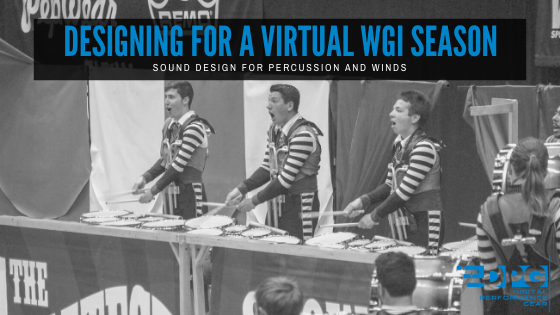WGI annouced that they would be hosting a virtual season in September, and a number of local circuits are also providing virtual performance opportunities for teams that are unable to travel this season. This gives many more teams the chance to participate in the 2021 season, but can also present challenges for percussion and winds teams in particular who cannot edit or add sound to their productions after they film their video. We’ve recently discussed the visual considerations you may have for a competitive group and a small ensemble this season, but we wanted to take a deep dive on how to approach sound in 2021.

We enlisted three percussion and winds professionals to help you think about the best ways to show off your performers on video. Justin Robards is a freelance audio engineer who works with Infinity Percussion in Orlando, Florida, Craig Myers is a member of the Board of Directors of the Minnesota Percussion Association, and Terry Sanders is the former director of Escambia HS Percussion in Pensacola, Florida. Please see their full bios below. We asked them to think back on their years of experience and how what they have learned can be applied in this unusual season.
Choosing Recording Environments for Virtual Percussion and Winds Performances
Craig reminds us that “every space, outdoors or indoors, can vary in its ability to sound good or bad. The sound will be heavily influenced by temperature, humidity, and a host of other factors which can alter quality within the same location or space, often in extreme ways.” But that, no matter what, performer safety should be your top priority when selecting a location.
Even though we’re used to performing in gyms for winter, when it comes to audio recording, gyms tend not to be an ideal space, giving off too much reverb during the recording process, and affect the clarity of the ensemble. If you have safe access to a large arena with good acoustics, this would obviously be the best choice, but is unlikely in most cases, so let’s explore our other options.
All of our experts agreed that outdoors would be optimal for sound and safety, though it may present some additional challenges. Justin mentions that outside would give a “great balance by being able to record the marching and playing together, however, we would be at the mercy of the weather.” In a place like Florida, dodging wind and rain on recording days might be the primary concern, but in Minnesota or other northern locations that have to dodge snow, outdoors may be out of the question. Craig advises that if you are unable to meet outdoors because of weather or other restrictions, that you’re sure to employ the use of PPE and utilize your facility’s largest spaces to ensure that social distancing standards are met.
If you’re fielding a concert percussion ensemble, you likely have more indoor options. Justin recommends an auditorium, as they usually have the best acoustics, and Terry reminds us that no matter the space, the more fabric, carpet, and other sound dampeners you have in a room, the better it will sound.
Band rooms are often better equipped for this purpose, and if you have the space, could be the best indoor location to record both concert and marching percussion performances. We discussed space considerations for video in our previous design blog, so be sure to think about your video considerations as well.
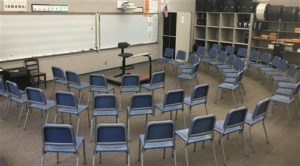
Craig provided us with a checklist when evaluating the places you may have access to:
-
Try to Avoid:
- Flat, reflective walls and ceilings, sometimes referred to as “boomy” rooms, or “echo chambers.”
- Wind, fans, or HVAC equipment near the microphone
- Dim or dark locations
- Low ceilings or no ability to elevate the camera and microphone above ground level
-
Try to Find:
- Acoustically “dry” rooms that incorporate sound paneling or dampening devices
- Well-lit areas
- Quiet spaces that aren’t normally affected by any interruptions or unwanted ambient noise
- Large rooms or outdoor spaces that safely allow for the recording personnel to be elevated above and placed back from the ensemble.
-
Potential Ideal Locations
- Outdoor Stadiums
- Outdoor Amphitheaters
- Large Gymnasiums or Arenas
- Performing Arts Centers
- Large Commons or Cafeterias
- Parking Lots with an adjacent hill or safe structure, like your marching band tower or lift
Recording Tips & Tricks for Percussion and Winds Teams Planning a Virtual or Hybrid Season
Based on your location, resources, and personnel, you may have more or less help while planning and preparing to record your virtual performance. Even professional audio engineers like Justin are reevaluating the ways they plan to address mixing and recording during a virtual season. The good news is, no matter what your resources are, you can take steps to make your performers sound their best on video. Craig categorized these into the good, better, and best tips:
Good
- Nominate a staff member whose smart phone is best equipped to record your performances. Make sure there is adequate storage on the device so the recording doesn’t get cut off mid-performance. Be aware of the device’s camera and mic and remember to keep fingers and palms clear of these areas.
Better
- Consult with your staff, membership, volunteers and seek out any audio/visual equipment options that they or a friend or family member might own or have access to. Devices should ideally be able to record in High-Definition video (1080p or higher) and High-Resolution audio (44.1 kHz/24-bit or greater). It is also a good idea to utilize an external microphone that is of higher quality than the built-in mic in most cameras. Ensure the devices are compatible with one another by reading the tech specs or searching online and be sure to test on your own before setting up a recording run through.
Best
- If an ensemble already owns or has access to a professional camera and microphone equipment, that will set them up for having high-quality recordings. For scholastic groups, it is a good idea to check with your school’s media or A/V department to see if any of their audio/visual equipment is available for rental or check out. For independent ensembles, search for audio/visual rental services in your area and ask for options and a price quote on a single day or season-long rental. Then, evaluate if you can allocate some of your budget towards renting professional gear, perhaps funds that are normally allocated to travel or hotels.
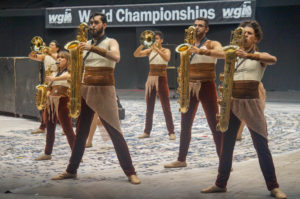
FIU Indoor Winds at the 2019 World Championships
Whichever recording methods you choose, Terry reminds us that balance between the front ensemble and the battery is key, especially if you’re in an indoor environment which tends to lend itself to a dominant battery sound. Be aware of the built-in compressors in most cameras that are designed to “squash” sudden loud sounds. An external microphone could help with this, but a direct feed from the mixer of the front ensemble in addition to an ambient room microphone could be ideal, and doable, even on a budget.
If you have an audio engineer on staff, or have the ability to bring one in, he or she will have a lot to consider this season to make your ensemble sound its best. Justin gives us some insight into his process for an independent world percussion team this season:
“For indoor, I tend to only use a few scenes to revert to during our performances. This is because of the lack of access to the mixer to change scenes on the fly (unlike DCI and many marching band circuits where an audio engineer can have direct access to the mixer and ‘live mix’). It is my belief that more mixes will be necessary to record not only what the front ensemble is playing, but also utilizing extra mics to record the acoustic battery instruments for the performance. Since many programs I work with use shotgun field mics, my plan is to implement them into the recording process. Therefore, I will have separate inputs from the front ensemble mix included with the set-up field mics that I will implement. This way, everything will not only be in sync for the recordings, but also give me plenty of time to listen to specific show chunks in rehearsal to balance out the battery with the front ensemble. We will most likely make use of sound dampening for the mallet instruments to keep the battery from bleeding into the mallet mics. Finally, I will need to use some noise gates for the mallet instruments (again to help stop bleed through) and also compression for the field mic battery mics so that every battery note is recorded with a proper signal. In order to sync up with the video, we will work together with the videographers to make sure everything is synced up.”
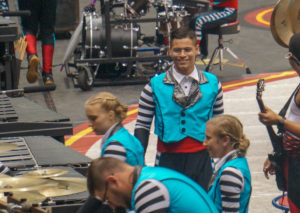
Infinity World at the 2019 World Championships
Tips for Testing your Sound Before Recording
Craig and Terry provided some great tips for those who might be working without the help of an audio engineer or someone with more experience in audio recording.
- Ensure you are getting a signal by snapping near the microphone and monitoring volume meters for a response.
- Test the ensemble’s extreme dynamic ranges:
- Watch out for “Peak/Limit” indicators or Volume Meters that go above 0 dB. These often warn that the recorded audio will become distorted and damaged and will glow red when this occurs.
- Craig recommends reducing the “Gain” setting or placing the microphone further away from the ensemble to avoid this particular issue.
- Don’t forget the quietest moment in the performance too!
- Ensure all musical details can still be heard clearly and aren’t covered up by ambient and unwanted noise. Here you can increase the gain setting or move the microphone closer to the ensemble to avoid this problem.
- If you’re outdoors, you may want to make use of a windscreen on the microphone to avoid unwanted noise.
- Always listen to your sound in headphones. It will be a truer test of what the final product will sound like.
- Watch out for “Peak/Limit” indicators or Volume Meters that go above 0 dB. These often warn that the recorded audio will become distorted and damaged and will glow red when this occurs.
If you or someone on your staff has more experience with sound, or you’re able to bring in an audio engineer, Justin gave us a great example based on what he is planning for some of his teams:
“The setup I am imagining and planning out is actually a pretty simple setup with the already included equipment, making setup and breakdown an added 5-10 minutes before and after rehearsal. With the front ensemble’s mixer already in use, there may be 4-5 unused inputs available for the battery mics. With all of that said, ensemble rehearsals are where I expect to do most of my mixing. As the instructors are rehearsing show chunks with the members, I can use those as dry runs for the recording process. That will leave me able to hear exactly what the designers want to hear at certain points in the recording process. I believe some of the best videos will come out of this experience, and hopefully a reason to allow audio engineers to live mix for WGI, besides the often-unreliable wireless mixing route.”
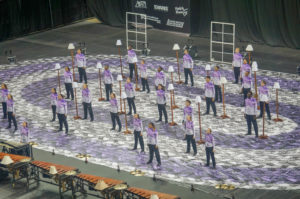
Escambia HS at the 2019 WGI World Championships
Small Ensemble Considerations
As we discussed in our previous blog on designing visually for small ensembles, while you still can’t edit your video footage, the camera doesn’t have to be fixed like in the group competitive division. No matter where you decide to record your small ensemble, keep the same sound and safety principles in mind.
Here are some small ensemble tips to remember:
- Keep the same health and safety guidelines in place. Multiple performers in a small practice room isn’t a great solution during a pandemic.
- Be sure there are good sight lines for the camera and that everyone and their instruments are visible during the recording.
- Test your audio and visual just as you would for your large group, as discussed above.
- Place the camera on a tripod or level, stable surface to avoid a shaky or tilted picture.
- If you are planning to move the camera, you may want to invest in or borrow a gimbal to provide smooth movement. If you go this route, be sure to practice with it before you try to record with it. There are plenty of decent, inexpensive gimbals for phones that can accommodate an external microphone, as well as the larger, more professional camera versions.
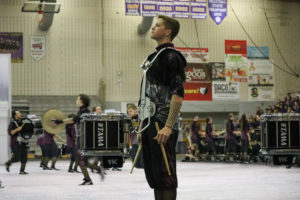
Additional Tips for a Great Experience!
- Bring in an expert! Often there is someone in your ensemble’s network that has experience with best practices in recording. You’d be surprised what coffee and donuts can do to raise the professionalism of your recording sessions.
- Many people in the activity have gone on to amazing audio/visual careers, and being able to help their home team as an alumnus, or giving back to the activity after a few years off is something they might be interested in. Don’t be afraid to reach out!
- Don’t forget your on-campus resources. Scholastic teams should be sure to reach out to their TV Production and media teachers and students. They may have insights that can help you put together your best product.
- Lighting is important too! If the lighting is poor, it gives an overall dull look to your presentation. Learn more about visual design here!
- Try doing several “takes” when possible and choose the best recording for that session.
- If you want to enter your submission in a competitive category, often that means that there should be no editing of audio or video during the performance. If you wish to have more freedom to edit and be creative with the project, many circuits have a separate, non-competitive class to enter so you can still share your performances. Consult your local circuit or www.wgi.org for more information.
- Safety first! Masks on, social distance as much as possible, and be safe out there!
Let us help you put it all together!
We hope this was helpful information for planning out your virtual or hybrid season. If you’re ready to start on your floor, uniforms, face masks or other 2021 show needs, don’t forget that our Fall Sale was extended until January 15, 2021 to help you get all your plans together! Save 15% on all the custom-printed gear we produce in house! Contact an Account Executive today for help!
About our Contributors:
Craig Myers
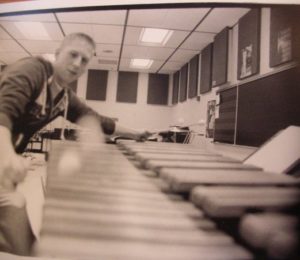
Craig Myers is an active percussion educator, clinician, composer, and arranger from Minneapolis, MN. He currently serves as the Sound Designer/Engineer for River City Rhythm Drum and Bugle Corps (Anoka, MN) and Front Ensemble Arranger for Jubal Drum and Bugle Corps (Dordrecht, NL). Over the past decade, Craig has worked with over 50 music programs including Eden Prairie HS (MN), The Colts Drum and Bugle Corps (IA), Minnesota Brass Drum and Bugle Corps (MN), Waconia HS (MN) and continues to run a successful private lesson studio. He serves on the Board of Directors for the Minnesota Percussion Association and coordinates the annual MPA Leadership Summit. Craig has performed as a World Class finalist with Rhythm X (2008 WGI PIW World Champions), The Cadets Drum and Bugle Corps, and the Bluecoats Drum and Bugle Corps. He received his Bachelor of Music in Percussion Performance from St. Cloud State University, and is an AV Support Technician for AVI-SPL.”
Justin Robards

Terry Sanders
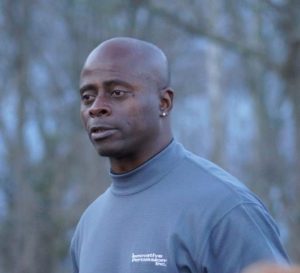
Terry Sanders received his degrees in Music Education and Computer and Information Science from Troy State University. He studied percussion under Dr. Samuel Frederick, while marching with the “Sound of the South” Trojan Band. Mr. Sanders studied clarinet with Dr. John M. Long in the Troy State Reading Band. He also studied percussion privately with Sergeant Carl Griggs of the United States Marine Drum and Bugle Corps. Mr. Sanders was the Co-Percussion Caption Head and arranger for the Florida Wave Drum and Bugle Corps from 1980 – 81.Mr. Sanders was the Director of Percussion at Escambia High School in Pensacola, Florida for 30 plus years. Under his direction, the Escambia HS Percussion section has won over 40 High Drum Caption awards and has received no less than a superior rating at any Band Competition since 1982. Mr. Sanders was the founder of the award winning, Escambia HS Diamonds Indoor Percussion Ensemble. The Diamonds have been competing in WGI Regional Championships as well as WGI World Championships and since 1997. Mr. Sanders also was the Program Coordinator for The WGI 2017 PIO Bronze Medalist Freedom Percussion Ensemble.
Mr. Sanders was responsible for creating the largest PAS Day of Percussion Marching Clinic in the Southeast United States. Doing clinics and master classes with the following: Scott Johnson, Jeff Prosperie, Shane Gwaltney, Dr. Omar Carmanates, Brian Nozny, Sean Vega, Danny Raymond, Joe Hobbs, Bill Bachman, Mike McIntosh, Andrew Tucker. Elanders Frazier, Harvey Thompson, John Lluvea and Infinity Basses, Jeff Moore, Matthew Filosa and the FSU Percussion Section, Luis Rivera and the USA Percussion Section and Clint Gillespie and Dr. Andrew Lynge and the Jacksonville State University Percussion Section.
Mr. Sanders actively serves as a championship level adjudicator for fall marching competitions and indoor percussion competitions. He is a currently an official WGI Percussion Judge. He is an active member of, the Indiana Percussion Judges Association, the Texas Color Guard Circuit, Georgia Indoor Percussion Circuit, Florida Federation Color Guard Circuit, the Arizona Percussion Circuit, the Mississippi Indoor Association Circuit and the Southern Association of the Performing Arts Circuit, Florida Marching Band Coalition, and the Southeastern Color Guard Circuit.
Mr. Sanders currently serves on the Board of Directors for the Gulf Coast Color Guard and Percussion Circuit and he has served many years on the WGI Percussion Advisory Board, most recently in 2016. He is a member of Phi Mu Alpha music fraternity and he is an active member of the Percussive Arts Society and currently serves on the PAS Marching Percussion Committee. Mr. Sanders also works with Southwind Drum and Bugle Corps as the Program Coordinator. Southwind was awarded the most improved corps for the 2019 DCI season.
Terry is currently an Educational Artist endorser for Innovative Percussion, the REMO Drum Head Company, Sabian Cymbals and the Pearl /Adams Drum Company.



